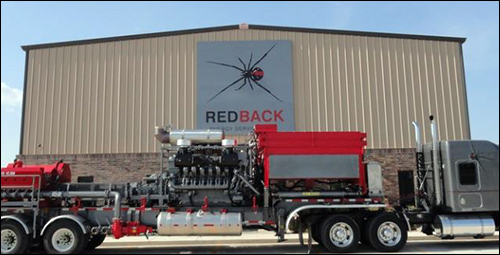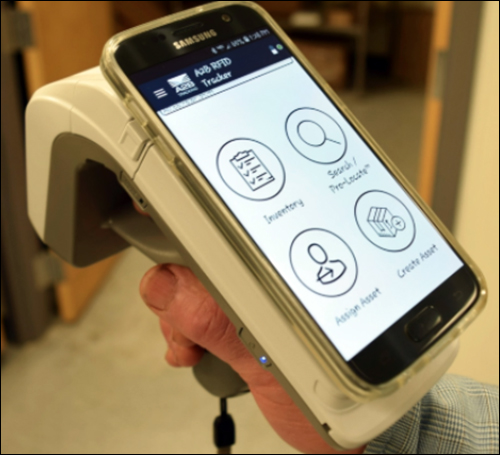Redback Energy Services is reducing labor hours and improving efficiency as it assigns, ships and receives back the rental equipment that its oil and gas customers use, thanks to a recently deployed RFID solution. According to technology provider A2B Tracking, an inventory-counting process that previously took one week and had the potential for errors can now be accomplished within a single hour. The solution consists of UHF RFID tags epoxied to heavy equipment, a Zebra Technologies RFD8500 handheld reader and an app to enable data regarding goods being rented out or received.
Redback Energy Services is a rental equipment and service provider for the oil and gas industry. Each year, the company provides thousands of pieces of equipment, including separators, phalanges and valves, as well as large items such as trailers used by companies that produce natural gas or crude oil. The firm covers Oklahoma and Texas with a main distribution center, in addition to several satellite locations nearer to the sites where the equipment is used.
After customers place orders, Redback Energy Services can deliver those goods to their sites as needed, or customers can pick up the equipment themselves. These customers consist of oil and gas companies, as well as contractors for those businesses. Goods can often move from one site to another as they are returned from customers, maintained, inspected and made available for another project or customer.
Tracking each item and its status is a complex task that was performed manually, while inventory-counting checks of all the assets at all sites was carried out at least quarterly. The company must meet the Sarbanes-Oxley Act’s requirement that full physical inventories be counted every quarter and every year, and they must keep track not only of their physical inventory but also the value of those goods on a balance sheet. When the inventory counts are conducted manually, the process is time-consuming, requiring approximately a week of counting and reconciling, and has the potential for errors.
The company approached A2B Tracking in 2018 to find a solution, according to Daniela Zounek, A2B’s senior implementation engineer, and the system was taken live in spring of that year. The solution is now live at its central site in Elk City, Okla., as well as at several other sites around Oklahoma and Texas.
First, the company began attaching passive UHF on-metal RFID tags to a variety of makes and models of each piece of equipment. The unique ID number encoded on each tag is linked in the software to data about the specific equipment to which it is attached. Because of the variety of machinery types, A2B Tracking worked with Redback Energy Services to find the right tags for each size, shape and material, as well as the orientation of the tag that makes it easiest to interrogate with a reader.
Once an order is placed for a particular piece of equipment, warehouse personnel can use A2B’s Pro-Locate function in the app to search for each item. Redback Energy Services’ warehouse operators each have an Android-based cellphone running the A2B tracking app, as well as a Zebra handheld RFID sled-based reader that has a Bluetooth connection to that phone. A user can simply open the app and prompt the reader to enter Geiger counter mode, enabling it to locate the item as the operator moves throughout the warehouse. The reader will chirp once it detects the signal coming from the requested tagged item.
When a customer’s order is fulfilled, the equipment being rented is loaded onto the truck that will deliver those items. The operator reads the tags of the goods being loaded, and they can be grouped together as part of a single order. A2B Tracking’s cloud-based software stores data related to the order and each item, including the customer receiving that item and the date on which it was loaded. The status of each piece of equipment and the entire order is stored in the software so management can view that information from a computer at any time. Users can link other data to each item or order, such as when it is expected to be returned.
When goods are received back from a customer, Zounek says, “They simply use the handheld reader to check it back in.” Each item’s status is then updated in the app and software platform. If equipment is moved to another depot or some other location, that status is updated to the software as well. Redback Energy Services has the ability to run customized reports based on the RFID data captured, such as when goods were shipped and returned, and when exceptions took place. In that way, employees can perform analytics in order to understand each customer’s performance, by looking at the status of existing rentals and viewing when delays might take place.
The greatest challenge for the deployment, according to the company, was to ensure that each unique piece of equipment could be properly tagged, and that every tag could be reliably read. Because of the harsh environment involved, the tags were epoxied into place.
While Redback Energy already captures and stores photos of equipment linked the RFID tag data, the energy services company could opt in the future to store other documentation about products in the software, along with their inspection and maintenance histories, thereby automating data related to maintenance tracking. “There’s room for more expansion within the system,” Zounek says, to use all the features available.




